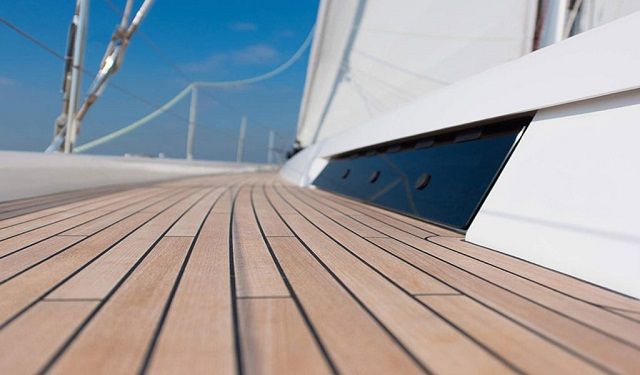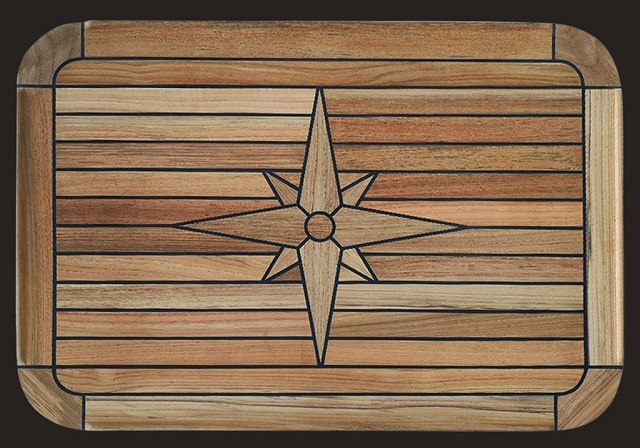Essential tips for restoring teak deck rubber seams on your yacht in Greece

Owning a yacht with a beautiful teak deck is a luxury many sailors cherish. However, over time, the rubber seams between the teak planks can wear down, compromising both aesthetics and functionality. Restoring these seams requires careful consideration and skilled professionals, especially when in Greece, a country renowned for its maritime culture and stunning coastlines. Here are essential tips to guide you through the process of restoring teak deck rubber seams on your yacht in Greece. On our homepage, you can read more about our exceptionally high-quality and beautifully finished wooden design products at realistic prices. (To ensure the privacy of our customers, you can contact us for references.)
Read this text in Greek
Buitenschrijnwerk also builds and repairs wooden teak decks in the following areas and cities: Athens, Corfu and Kefalonia.
These are all our working areas.
Main concerns when you wish to have your teak deck seams restored
Restoring wooden teak deck rubber seams involves addressing several key concerns:
- Seam integrity: Ensure that the seams are effectively repaired to prevent water ingress, which can lead to deck damage and structural issues.
- Aesthetic appeal: The appearance of the wooden teak deck greatly impacts the overall look of your yacht. Proper seam restoration enhances the beauty of the deck.
- Durability: Use quality materials and techniques to ensure the restored seams last and withstand the harsh marine environment.
- Skill and expertise: Hiring experienced professionals is crucial for achieving a high-quality restoration job.
- Environmental impact: Choose restoration methods and materials that minimize environmental impact. Opt for eco-friendly products and techniques to ensure sustainability and reduce your yacht's carbon footprint.
Do you need some extra advice? Feel free to contact us.

Inspirational examples of wooden teak decks
Wooden teak decks are not only functional but also add timeless elegance to any yacht. Some inspirational examples of well-maintained teak decks include:
- Classic sailing yachts: Many vintage sailing yachts feature stunning teak decks that have been meticulously cared for over the years.
- Modern yacht designs: Contemporary yachts often integrate teak decks into sleek, minimalist designs, showcasing the versatility of this material.
- Luxury superyachts: Some of the world's most luxurious superyachts boast expansive teak decks, highlighting the prestige associated with this decking material.
Contractors for teak deck rubber seams repair in Greece
Finding reputable contractors for teak deck rubber seams repair in Greece requires thorough research and recommendations. Consider the following steps:
- Local referrals: Seek recommendations from fellow yacht owners or marina staff who have experience with deck restoration.
- Online reviews: Use online platforms to research contractors with positive reviews and testimonials from satisfied clients.
- Specialized yacht services: Look for contractors specializing in yacht maintenance and restoration, particularly those with expertise in teak deck repairs.
Buitenschrijnwerk is also very experienced in building wooden jetties.
Costs for wooden teak deck restoration
The costs associated with restoring wooden teak decks can vary depending on several factors:
- Deck size: Larger decks require more materials and labor, thus increasing the overall cost.
- Condition of the deck: Extensive repairs due to severe wear and tear will incur higher costs compared to routine maintenance.
- Labor and materials: Skilled labor and premium materials contribute significantly to the total restoration expenses.
- Location and accessibility: Geographic location and accessibility to the yacht can affect transportation costs and overall project pricing.
It's advisable to obtain multiple quotes from reputable contractors to compare costs and services before proceeding with the restoration.
In conclusion, restoring teak deck rubber seams on your yacht in Greece demands attention to detail, quality craftsmanship, and an appreciation for the natural beauty of wooden teak decks. By prioritizing seam integrity, exploring inspirational examples, engaging reputable contractors, and understanding cost considerations, you can ensure a successful and visually stunning restoration project that enhances both the appearance and functionality of your yacht's teak deck.
Request a quote to have your teak deck rubber seams on your yacht or ship repaired
Frequently asked questions about ship decks
WHAT ARE THE BENEFITS OF A TEAK BOAT DECK?
A teak boat deck is attractive because of its natural beauty, durability against the elements, non-slip properties, easy maintenance, insulating benefits, timeless appearance and environmental friendliness. In short, it offers not only aesthetic benefits but also durability, safety and comfort, making it an excellent choice for boat and yacht owners.
HOW DO I MAINTAIN A TEAK BOAT DECK?
Regular maintenance of a teak boat deck is crucial to keep it beautiful and durable. Here are the steps:
- Regular cleaning: Sweep the deck to remove dirt and sand. Avoid abrasive brushes.
- Fresh water rinsing: Rinse after salt water use to prevent damage.
- Deep cleaning: Periodically clean thoroughly with teak cleaner and soft brush, followed by rinsing.
- Light sanding: If aging or roughness occurs, lightly sand with fine sandpaper in the wood grain direction.
- Oiling: Protect and preserve color with teak oil. Apply according to instructions and remove excess oil.
- Optional sealing: Some choose additional protection with an appropriate sealer.
- Regular inspection: Check for and repair loose boards and caulk seams. Replace worn sealant seams.
- Prevent damage: Avoid heavy or sharp objects on the deck; use rubber mats or cushions.
This routine will keep your teak deck attractive and resistant to marine conditions. Maintenance is essential to maintain the value of your vessel.
CAN I INSTALL A TEAK DECK MYSELF OR DO I NEED PROFESSIONAL HELP?
Installing a teak deck yourself is possible if you have the right skills, tools and time. However, installing a teak deck can be complicated because of the precise measurements, carving and finishing required. If you have no experience in carpentry or laying teak decks, it may be wise to enlist professional help to ensure that the deck is installed correctly and lasts a long time. A professional installer can also offer advice on proper treatment and maintenance to extend its life.
HOW LONG DOES A TEAK DECK LAST ON AVERAGE?
A teak deck can generally last for decades if properly maintained. However, the exact number of years depends on several factors, including the quality of the wood, the frequency of maintenance and the environmental conditions in which the deck is located. With regular maintenance and responsible use, a teak deck can maintain its aesthetics and functionality for many years.
WHAT IS THE DIFFERENCE BETWEEN SOLID TEAK AND TEAK VENEER FOR SHIP DECKS?
The main difference between solid teak and teak veneer for ship decks is in their construction and materials:
Solid Teak: These decks consist entirely of solid teak with no other materials. It is durable, weather resistant and has natural oils against rot and mildew. It offers an authentic teak look and is thicker and more durable, suitable for heavy use.
Teak veneer: Teak veneer consists of a thin layer of teak glued to a base of plywood or other wood material. It is cost-effective because it uses less teak wood. Although it still has the aesthetics of teak, it is thinner and more susceptible to wear, especially if the veneer is damaged and the underlying material becomes visible.
Your choice between the two depends on your budget, aesthetic preference and intended use. Solid teak typically offers more durability, while teak veneer can be a more cost-effective option that still retains the look of teak. Think carefully about which material best meets your needs when choosing a finish for your boat deck.
HOW CAN I REMOVE STAINS OR DISCOLORATION ON MY TEAK DECK?
To remove stains or discoloration from a teak deck, follow these steps:
- Cleaning: Use a teak cleaner or a mild mixture of soap and water with a soft brush to remove dirt and stains. Rinse thoroughly with clean water.
- Sanding: If the stains are deep, gently sand with fine sandpaper in the wood grain direction.
- Bleaching (optional): For stubborn stains, consider teak bleach and rinse well.
- Restore color: Apply teak oil or sealer to restore the original color and provide protection.
Remember that regular maintenance and preventing stains are the best way to keep your teak deck in good condition. Clean up spills such as oil or red wine immediately and clean and treat the deck regularly to protect it from the elements.
WHAT TREATMENTS OR FINISHES ARE NEEDED TO KEEP A TEAK DECK IN GOOD CONDITION?
To properly maintain a teak deck and extend its life, the following steps are necessary:
- Cleaning: Clean regularly with teak cleaner or a mild soap mixture to remove dirt and surface contaminants.
- Sanding (if necessary): If necessary, lightly sand with fine sandpaper to remove deep stains or discoloration.
- Oil or sealer: Apply teak oil or sealer to nourish the wood, protect it from moisture and UV rays, and maintain its natural color.
- Periodic inspection: Regularly check for loose boards and caulk seams for timely repairs.
- Stain prevention: Avoid spills of potentially harmful substances such as oil, wine and chemicals and clean up immediately.
- Regular maintenance: Repeat these steps regularly every few months, depending on use and conditions.
This ensures that your teak deck remains in top condition, maintaining its natural beauty and durability. Maintenance is essential for preserving teak decks.
HOW CAN I PREVENT A TEAK DECK FROM BECOMING SLIPPERY?
To keep a teak deck safe and prevent slipping, you can take the following measures:
- Keep the deck cleaned regularly to remove dirt and algae, which can cause slipperiness.
- Improve grip by using non-slip products such as mats or strips.
- When oiling the deck, choose oils with anti-slip additives to provide extra grip.
- Place rubber mats in promising areas and wear shoes with good grip.
- Rinse away soap residue thoroughly after cleaning to prevent slipperiness.
- Quickly remove water puddles after rain or deck rinsing, as water can cause slipperiness.
- Move carefully, especially on a wet teak deck, to avoid slipping and ensure general safety on board.
ARE THERE ALTERNATIVE MATERIALS TO TEAK SUITABLE FOR SHIP DECKS?
Yes, there are alternative materials to teak that are suitable for ship decks. Some of these options include synthetic deck materials such as synthetic teak (for example, Flexiteek or Teaklite), synthetic deck boards such as PVC or composite decking, and other hardwoods such as ipe or mahogany. These materials can be durable, low-maintenance and non-slip, making them attractive alternatives to teak for boat decks. However, aesthetics may differ.
WHAT IS THE COST OF INSTALLING AND MAINTAINING A TEAK BOAT DECK?
The cost of installing and maintaining a teak boat deck varies greatly. These costs are influenced by factors such as deck size, wood quality, labor costs and maintenance products. Initial installation costs can be significant, ranging from thousands to tens of thousands of dollars, depending on project size and craftsmanship costs.
Maintenance includes regular cleaning, sanding, oiling or sealing, and any repairs. These costs vary, but are typically between several hundred to thousands of dollars per year, depending on deck size and care required.
It is important to realize that investing in a teak boat deck involves not only an initial cost, but also ongoing maintenance costs to maintain its beauty and durability.


